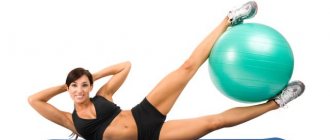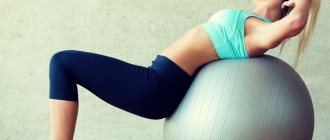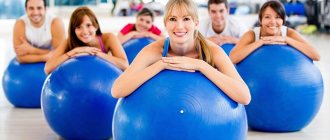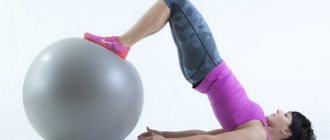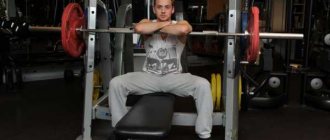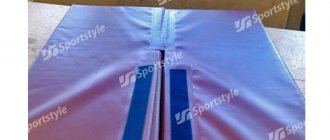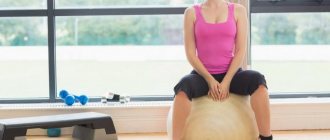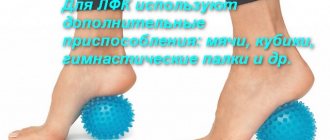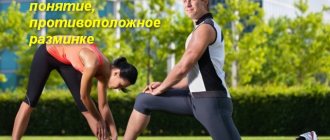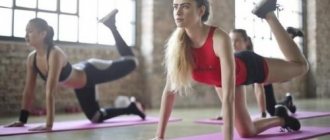Effective exercises to keep the body in good shape in some cases involve the use of additional sports equipment. If in the gym, a woman has the opportunity to work out with all the equipment presented in the establishment, then at home it will be difficult to significantly transform herself with the help of available weights.
To effectively get rid of fat, as well as increase muscle relief, fitness trainers recommend using a fitball in home exercises.
How to choose the right ball
Exercises with a fitball for the whole body, provided they are performed regularly, will bring visible results to a woman, provided that the ball used in training is chosen correctly.
A fitball (or “Swiss ball”) is a large rubber ball with increased strength and elasticity. It is actively used by professional athletes in preparation for competitions and by fitness trainers to qualitatively transform the body of their clients.
With its help, in most cases it is possible to:
- use all muscle groups of the athlete’s body, while avoiding negative effects on the joints and cardiovascular system;
- increase a person’s dexterity, coordination and flexibility, regardless of his age;
- correct posture;
- carry out the prevention of diseases of the joints and skeletal system associated with the thinning of cartilage tissue;
- lose excess weight in the shortest possible time without putting the body into a state of stress;
- keep your figure in shape by regularly performing a basic set of exercises that do not require a lot of time and physical investment.
To choose the right tool for training, a woman should decide what type of fitball she needs in specific circumstances.
There are 4 types of balls:
- With “horns” that allow you to maintain balance. Recommended for sports activities for children and beginner athletes with low physical fitness.
- With spikes" . Recommended for use by people planning to lose excess weight through fitball exercises. Rubber protrusions – “spikes” – serve as an additional stimulation of blood circulation, which directly affects the condition of human skin.
- Smooth . Can be used by people of all ages. Most often, this type of fitball is recommended for pregnant women. With the help of a ball, expectant mothers can not only maintain the elasticity of ligaments and muscles, but also ease contractions at the time of the onset of labor at home.
- Children's. A fitball of minimal size, used to strengthen the muscles of infants.
A properly selected fitball must meet the characteristics of high-quality sports equipment:
- The ball should be selected according to the girl’s height. Recommended ratio: height less than 155 cm - ball 45 cm in diameter; height 155 – 169 cm – the ball is no more than 55 cm in diameter; 69 – 185 cm – diameter – 65 cm; more than 186 cm – diameter more than 75 cm).
- When there is a mechanical impact on the ball, for example, pressing on it with the palm of your hand, the rubber projectile should spring back.
- The fitball must withstand the maximum weight specified by its manufacturer without being unduly deformed.
- The seams on the ball should be invisible.
- No static effect.
- Maximum depression of the nipple into the ball.
How to Burn More Calories and Get the Most Out of Your Workout
- UPDATE PLAY LIST.
Studies have shown that those who exercise while listening to rhythmic pop or rock music exercise 15% longer than those who prefer silence. - DO A MIX.
It has been proven that if you constantly change the set of exercises, the workout will not get boring. Combine boldly: aerobics and an exercise bike, a complex with a body bar and a dance class. - STAY CLOSE TO THE STARS.
Hit the treadmill next door to an endurance athlete. Or in a group strength training session, stand behind a girl who is doing the exercises well. It’s an indisputable fact: if someone around you is giving it your all, then you will put in more effort. - Vary the pace
...during your cardio workout. Speed up for a short period of time, then slow down. For example: walk calmly for three minutes, and run quickly for one minute - and so on for half an hour. According to statistics, women who exercised on an exercise bike, changing the pace of the load, burned three times more fat than those who pedaled at the same rhythm.
The word “callanetics” is probably familiar to those who are struggling for a beautiful figure, trying to get rid of excess weight.
To help such people, trainer Tatyana Rogatina has developed her own set of exercises that can be performed at home.
Tips for training with a fitball
Exercises with a fitball for the whole body require strict adherence to the technique of their implementation. Otherwise, the type of load in question will not only have minimal effectiveness, but may also cause the athlete to suffer an injury or sprain.
To avoid this, it is important to follow the basic recommendations for training with a fitball:
- Before and after class, devote the proper amount of time to warm-up and cool-down , respectively. This approach to organizing training will allow a girl, regardless of the level of the chosen load, to minimize muscle pain after working them out on the ball.
- When performing exercises, focus on quality rather than speed, trying to feel the muscles working as much as possible under any type of load.
- Perform exercises to work all muscle groups , not just the problem area. Ignoring this recommendation can lead to overtraining, as well as significantly worsen the overall appearance of the athlete.
- Adjust the density of the fitball inflation depending on the girl’s physical fitness. The more the ball is inflated, the higher the level of difficulty of performing exercises on it. During the first exercises, it is recommended to slightly deflate the sports equipment, thus allowing the body to gradually get used to physical activity.
- To achieve the desired result in the shortest possible time, it is recommended to contact a fitness trainer who is able to properly organize the training process, taking into account the client’s health condition, her goal and level of physical fitness. If it is not possible to use the services of a professional, it is recommended to build your classes on the principle of circuit training.
- Perform exercises that do not cause pain or significant discomfort. For example, people with poor vestibular apparatus should initially avoid exercises that involve rolling on a ball or face-down rotational movements.
- If it is necessary to increase the load , it is not recommended to perform more repetitions than the training program provides. In such circumstances, fitness trainers recommend modifying the load by artificially creating the need to use weights, such as dumbbells.
When exercising with a fitball, as with other types of physical activity, it is recommended to pay attention to your well-being during the first workouts, as well as after increasing the load.
A slight malaise or a more acute reaction of the body to sports should be a reason to contact a doctor for an additional examination.
Historical reference
The plastic ball was first made in the 60s by Italian petrochemist Aquilino Cosani, who, although not used in the fitness industry, is still a pioneer in its production. Swiss doctor Suzanne Klein-Wogelwatsch pioneered the use of inflatable plastic balls in the orthopedic field at the physical therapy clinic she founded. Therefore, a fitball is often called a “Swiss ball” and not an Italian one, since the first set of exercises with it was developed in Switzerland.
In the 80s of the last century, the concept of physical exercise with inflatable balls was brought from Europe to America by Joanna Posner-Mayer. She was the first to promote the use of fitballs in the sports industry. From this moment on, the inflatable ball quickly began to conquer new territories in the United States; it began to be included in the complexes of various gymnastics programs. Soon, balls began to be used as the main sports equipment for specific sets of exercises in the fitness industry.
Currently, many fitness professionals are popularizing the use of fitballs, and many athletes from a wide variety of sports include gymnastics with plastic balls in their training programs.
A wide variety of exercises with a fitball have been developed for different muscle groups. Balls are increasingly used in combination with other sports equipment. For example, to reduce the mobility of the ball, you can use a so-called stabilizer pillow, which is placed under the fitball and fixes it in one place during exercise. In addition, new sets of ball exercises are constantly being developed and developed, which involve the use of dumbbells and other objects.
Lower body exercises
Exercises with a fitball for the whole body are best structured so that at the beginning of the workout the main load goes to the lower part (legs, hips, buttocks). Considering the direction of lymph flow in the body, this method of organizing the lesson will allow the body to enter the training process as naturally as possible.
| Exercise with fitball | Technique for its implementation |
| Squats with arm raises |
|
| Wall Squats |
|
| Squats with a fitball clamped with knees |
|
| Gluteal bridge |
|
| Lunges |
|
Raising the body to the knees
Zone:
abs, front thighs.
Technique:
lie on your back, bend your legs at a right angle and, rounding your back, lift your body, stretching your arms forward until your palms touch your knees.
Error:
lifting the body with a straight back, and even more so with a deflection, not only reduces the necessary load on the abs, but can also injure the lower back muscles. Friends, watch our program and do fitness for problem areas without mistakes!
Exercises for problem areas are performed to tighten muscles and get rid of loose skin in areas of the body that bother women the most: buttocks, upper, middle and lower thighs, abdomen, as well as arms and legs. By doing a similar workout for problem areas for just seven minutes daily, you can get a great toning.
Upper body exercises
Exercises with a fitball for the whole body should equally involve both legs and arms. Upper muscle groups usually require more time to transform, so performing at least 2-3 arm exercises in each workout is a prerequisite for effective training.
| Exercise with fitball | Technique for its implementation |
| Fitball push-ups |
When performing this exercise, it is important to ensure that the abdominal muscles do not relax from the moment the load begins until it is completed. |
| Plank diagonally |
|
| Rolling the fitball forward |
|
| Reverse ball push-ups |
|
| Static bar |
|
Callanetics for weight loss with Tatyana Rogatina
Similar articles
Callanetics for beginners
Callanetics, its discussion, reviews and results
A special feature of its development is the combination of stretching (muscle stretching exercises) and performing static poses, some of which have something in common with yoga asanas.
Performing exercises helps improve metabolism, reduce the amount of fat deposits, and overall fit the figure. Since callanetics forces deep muscles to work, it is very effective: an hour of exercise is comparable in load level to 24 hours of aerobics, 7 hours of shaping.
Who is Tatyana Rogatina
One of the original callanetics programs was developed by Russian trainer Tatyana Rogatina, who is a certified professional and group fitness trainer.
She has developed two unique callanetics complexes: for beginners and for those who have already mastered the basics. In her lessons, Tatyana explains in detail why this or that pose is needed and how to do the exercises correctly.
Callanetics with Tatiana Rogatina
The complexes consist of exercises aimed at working the muscles of problem areas: hips, legs, arms, back, abdomen, chest.
- The initial complex includes 29 exercises, which should be performed every other day. The exercises require from 30 to 100 seconds, but at first the time can be reduced to 15 seconds.
- The complex for “continuers” is more difficult and requires preparation. If you have already achieved your desired figure, you can do it once a week. if “the process is still ongoing,” exercise 2-3 times a week.
Remember the standard requirements: the pause between classes and meals should be about two hours; You should not exercise before bed or immediately after waking up.
If you want to try other proprietary callanetics techniques, an excellent selection is collected in the article dedicated to video tutorials “Callanetics - online video lessons.”
Here you will find complexes developed by professional trainers, both domestic and foreign, with the help of which you can easily bring your figure into excellent condition.
Callanetics with Tatyana Rogatina – video
To start training with this system, it is not enough just to read the description of the poses - it is better to watch the trainer who performs them, giving detailed comments and explanations for each movement. This video will help you master the initial complex:
Please note that each lesson should begin with a warm-up , to which Tatyana pays special attention. This will prevent muscle injury and minimize muscle soreness the next day.
Beginners who have just gotten off the couch should not try to complete the exercises in full. After exercise, take a warm bath or shower to relax your muscles. Before exercising, jog for five minutes or take a brisk walk.
For those who want to develop further, the “Super Callanetics with Tatyana Rogatina” course is suitable. It is designed for people who have mastered the first part of the classes and perform the exercises without much difficulty. Continuing the course allows you to change the load, which has a positive effect on the condition of the muscles and improves the figure.
Video tutorial on supercallanetics
The peculiarities of these exercises include a stronger load, including on deep-lying muscles. Since the load on the muscles changes compared to the first part of the course, this will not allow them to “get used to” and work at half strength, thereby reducing the effectiveness of the training.
You should perform the exercises after pre-warming up (jogging or walking), without neglecting the warm-up and cool-down.
Callanetics with Tatyana Rogatina – reviews
Tatiana:
“When I saw the video tutorials of my namesake, I decided to try it out of pure interest. At first it was uncomfortable in literally every position. I gradually got involved and lost 5 kg in a month.”
Irina:
“I heard a lot about callanetics, but the “translated” lessons from foreign trainers did not inspire confidence.
Since Rohatina is our compatriot, I decided to try to study according to her system. In two months I lost 7 kg, and my figure became literally chiseled!”
Back and arm workout
Exercises with a fitball, aimed at working out the whole body, help not only transform a girl’s figure, but also improve her health, for example, by strengthening the back muscles that support the spinal column.
If you have spinal diseases, before performing this complex, it is recommended to consult a doctor to determine whether there is a need to adjust the loads.
| Exercise with fitball | Technique for its implementation |
| Reverse boat |
|
| Hyperextension |
|
| Bridge |
During the exercise, sudden movements are not allowed. “Bridge” is not recommended for people with a low level of physical fitness and dysfunction of the vestibular apparatus. |
| Leg raises lying on a fitball |
This exercise requires great muscle strength, as well as ideal condition of the vestibular apparatus. It is recommended to perform it at the beginning of a block of exercises to strengthen the back and arms. |
Contraindications
You can list an endless number of positive consequences from practicing callanetics. But, like any other type of physical activity, this area of fitness has a number of contraindications.
During “statics”, when holding certain positions, the muscles of the body are tense and compress the blood vessels. As a result, blood supply decreases.
After stopping work, all metabolic products are sharply released into the blood, and breathing increases. Due to this feature of static voltage, callanetics classes are prohibited when:
- deviations from the cardiovascular system;
- varicose veins;
- diseases of the organs of vision;
- spinal instability;
- diseases of the respiratory system, kidneys in the acute stage;
- injuries of the musculoskeletal system.
It is also necessary for persons to refrain from training during the postoperative period. During pregnancy and after childbirth, you should consult your doctor before exercising.
If you have just decided to take up callanetics, then start small: less repetitions, more rest. Listen to your body, be in harmony with it, and it will reciprocate.
Exercises on a fitball for the back and abs
An integral part of any set of physical exercises should be working out the abdominal area. The abdominal muscles, being in good shape, maintain normal blood circulation in the area of the woman’s pelvic organs, which ensures good health of the genitourinary system.
| Exercise with fitball | Technique for its implementation |
| Lifting the body at an angle |
|
| Transferring a fitball between limbs |
|
| Leg raises while lying on the floor |
|
| Body turns |
|
Any type of fitball helps not only improve the appearance of the athlete’s entire body, but also improve her health, and also minimize the risk of premature aging of the female body. Regular exercise of this type trains muscles, improves blood circulation, providing vital systems with sufficient oxygen.
This video contains one of the most effective sets of exercises for beginners:
With the correct preparation of the complex, as well as following the technique of conducting training with a fitness ball, a woman will notice the first positive changes in her condition after 1-2 months of regular training.
Exercises for problem areas
Prepare 2-4 kg dumbbells and a jump rope in advance. Take just three days a week out of your busy schedule to study. When you are done with the warm-up, perform each exercise for one minute and repeat the entire complex about three times. It is useful to add cardio training here (do it about 2 times a week).
Warm-up begins with jumping rope or standing still and lasts 30 seconds. Next, do jumping with touches, devoting the same amount of time to them. Repeat twice.
Touch jumping will warm up your body. To perform the exercise, place your feet together, lower your arms along your body, and stand straight. Now jump up, spreading your legs apart. When you land, bend your knees and touch the floor with your right hand, reaching back with your left. Next, jump up, keeping your feet together. You need to “jump” like this for a minute, not forgetting to change hands.
The warm-up is over.
